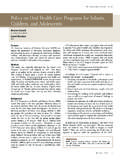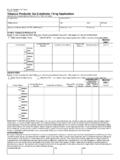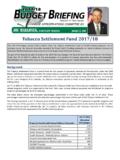Transcription of Policy on Tobacco Use
1 AMERICAN ACADEMY OF PEDIATRIC DENTISTRYORAL HEALTH POLICIES 69 PurposeThe American Academy of Pediatric Dentistry (AAPD), in order to reduce pain, disability, and death caused by nicotine addiction, recommends routine screening for Tobacco use, treating Tobacco dependence, preventing Tobacco use among children and adolescents, and educating the public on the enormous health and societal costs of This Policy was originally developed by the Council on Clin- ical Affairs and adopted in 2000. This document is an update of the previous version, revised in 2010. This Policy revision is based upon a review of current dental, medical, and public health literature related to Tobacco use which included a sys- tematic search of the PubMed /MEDLINE database using the terms: Tobacco , teen Tobacco use, Tobacco use in children, smoking, smokeless Tobacco , smokeless Tobacco and oral disease, pregnancy and Tobacco , secondhand smoke, and caries and smoking; fields: all; limits: within the last 10 years, humans, English, clinical trials, birth through age 19.
2 Websites for the American Lung Association, American Cancer Society, Centers for Disease Control and Prevention (CDC), Environ- mental Protection Agency, Campaign for Tobacco Free Kids, and Department of Health and Human Services also were Tobacco is a risk factor for six of the eight leading causes of deaths in the world, and it kills nearly six million people a Tobacco use is considered one of the largest public health threats the world has ever More than 600,000 deaths are the result of non-smokers being exposed to second-hand smoke. Approximately one person dies every six seconds due to Tobacco , accounting for one in 10 adult deaths. Up to half of current users eventually will die of a Tobacco related In the , the Surgeon General s report states that smoking is the single greatest avoidable cause of According to the report, The epidemic of smoking-caused disease in the twentieth century ranks amongst the greatest public catastrophes of the century, while the decline of smo- king consequent to Tobacco control is one of public health s greatest successes.
3 2 Youth Use of TobaccoThe CDC has conducted a National Youth Tobacco Survey (NYTS) for the years 1999, 2000, 2002, 2004, 2006, 2009, 2011, and 2012 as part of the Healthy People 2010 and 2020 objectives on Tobacco The NYTS also serves as a baseline for comparing progress toward meeting select Healthy People 2020 goals for reducing Tobacco use among youth, especially in adolescents in grades 6-12. The NYTS data shows that: Smoking and smokeless Tobacco use are initiated and established primarily during Nearly nine out of 10 smokers started smoking by age 18, and 99 percent started by age ,4-6 Each day in the , more than 3,200 people younger than 18 years of age smoke their first cigarette, and an estimated 2,100 youth and young adults who have been occasional smokers become daily cigarette ,8 If smoking persists at the current rate among youth in this country, million of today s population younger than 18 years of age are projected to die prematurely from a smoking-related illness.
4 This represents about one in every 13 Americans aged 17 years or younger alive In 2012, percent of middle school and percent of high school students currently used Tobacco products, including cigarettes, cigars, hookahs, snus, smokeless to- bacco, pipes, bidis and kreteks (unfiltered cigarettes from India), dissolvable Tobacco , and electronic ,10 From 2011 2012, electronic cigarette use doubled among middle and high school students, and hookah use increased among high school Current use of smokeless Tobacco is about half of what it was in the mid-1990s. However, only a modest de- cline has occurred since 2010 and no change occurred between 2012 and 2013. Smokeless Tobacco use remains a mostly male behavior,11 being seen in percent of male high school students and percent of fe- ,12 Review CouncilCouncil on Clinical AffairsLatest Revision2015 Policy on Tobacco UseABBREVIATIONS AAPD: American Academy Pediatric Dentistry.
5 CDC: Centers for Disease Control and Prevention. ETS: Environmental Tobacco smoke. NYTS: National Youth Tobacco ORAL HEALTH POLICIES AMA AERAICNEDNYIIIIIIOIFPITIESILIIIIIH6 ITIH9 Concurrent use of multiple Tobacco products is prevalent among youth. Among high school students who report currently using Tobacco , almost one-third of females and one-half of males report using more than one Tobacco product in the past 30 Most studies show that people who do not use Tobacco as a teen never use Aggressive marketing of Tobacco products by manufacturers,14,15 smoking by parents,16 peer influence, a functional belief in the benefits and normalcy of Tobacco ,17 availability and price of Tobacco products, low socioeconomic status, low academic achievement, lower self-image, and a lack of behavioral skills to resist Tobacco offers all contribute to the initiation of Tobacco use during childhood and adoles- Teens who use Tobacco are more likely to use alcohol and other drugs and engage in high risk sexual youth can be discouraged to start smoking, it is less likely that they will start smoking as an adult.
6 The 2012 Surgeon General s Report concluded that there is a large evidence base for effective strategies to prevent and minimize Tobacco use by children and young adults by decreasing the number of children who initiate Tobacco use and by increasing the cur- rent users who ,19 Oral health professionals can have success for Tobacco cessation by counseling patients during the oral examination component of dental of Tobacco Use Significant health consequences for Tobacco use include 440,000 deaths per year from secondhand smoke, of which 28 percent were ,12 Smoking increases the risk for: coronary heart disease by 2-4 times,6,11 stroke by 2-4 times,6 men developing lung cancer by 25 times,6 and women devel- oping lung cancer Smoking causes diminished overall health, increased absenteeism from work, and in- creased health care utilization and Other catastrophic health outcomes are cardiovascular disease; reproductive effects; pulmonary disease; cancers of the cervix, kidney, pancreas, stomach, lung, larynx, bladder and esophagus; leukemia; cataracts; abdominal aortic aneurysm; bronchitis; and other lung diseases including ,21 Secondhand exposure to Tobacco smoke imposes significant risks as well.
7 Cardiovascular disease and lung cancer are in- creased by 25 to 30 percent in nonsmokers who are exposed to and inhale secondhand Infants and children who are exposed to smoke are at risk for sudden infant death syndrome (SIDS), acute respiratory infections, middle ear infections, bronchitis, pneumonia, asthma,23,24 allergies,25,26 and infections during Caries in the primary dentition also is related to secondhand smoke Enamel hypoplasia in both the primary and permanent dentition also is related to children exposed to cigarette Prenatal exposure to secondhand smoke has been associated with cognitive deficits ( , reasoning abilities) and deficits in read- ing, math, and visuospatial new term, thirdhand smoke, has been proposed to de- scribe the particulate residual toxins that are deposited in layers all over the home after a cigarette has been These volatile compounds are deposited and off gas into the air over ,35 Since children inhabit these low-lying contaminated areas and because the dust ingestion rate in infants is more than twice that of an adult, they are even more susceptible to thirdhand smoke.
8 Studies have shown that these children have associated cognitive deficits in addition to the other associated risks of secondhand smoke Tobacco use can result in oral disease. Oral cancer,22 perio- dontitis,36-39 compromised wound healing, a reduction in the ability to smell and taste, smoker s palate (red inflammation turning to harder white thickened tissues), and melanosis (dark pigmenting of the oral tissues), coated tongue, staining of teeth and restorations, implant failure, and leukoplakia40,41 are all seen in Tobacco users. Smokeless Tobacco is a risk factor for periodontal conditions,42-44 oral cancer,45 caries, and tooth ,47 The monetary costs of this addiction and resultant morbid- ity and mortality are staggering. Annually, cigarette smoking costs the $289 billion, based on lost productivity (more than $156 billion) and health care expenditures (more than $133 billion).
9 8 The health care cost from the exposure to secondhand smoke is about $10 billion Contrast this with Tobacco industry expenditures on advertising and political influence of $ billion in 2011 in the Current trends indicate that Tobacco use will cause more than eight million deaths a year by It is incumbent on the healthcare community to reduce the burden of Tobacco - related morbidity and mortality by supporting preventive measures, educating the public about the risks of Tobacco , and screening for Tobacco use and nicotine statement The AAPD opposes the use of all forms of Tobacco including cigarettes, pipes, cigars, bidis, kreteks, and smokeless Tobacco and alternative nicotine delivery systems, such as Tobacco lozenges, nicotine water, nicotine lollipops, or heated Tobacco -cigarette substitutes (electronic cigarettes).
10 The AAPD supports national, state, and local legislation that eliminates Tobacco advertising and promotions that appeal to or influence chil- dren, adolescents, or special groups. The AAPD supports pre- vention efforts through merchant education and enforcement of state and local laws prohibiting Tobacco sales to minors. As environmental Tobacco smoke (ETS) is a known human carcinogen and there is no evidence to date of a safe exposure level to ETS (secondhand or passive smoke),22 the AAPD also supports the enactment and enforcement of state and local clean indoor air and/or smoke-free policies or ordinances prohibiting smoking in public places. Furthermore, the AAPD encourages oral health profes- sionals to: Determine and document Tobacco use by patients and the smoking status of their parents, guardians, and caregivers.















